Dell Studio 17: When Gaming Isn't Enough
by Dustin Sklavos on August 26, 2010 12:10 AM EST
General Performance
The configuration of the Dell Studio 17 we're working with is pretty much bog standard once you get into the quad-core builds. What's interesting is that Dell doesn't even ship the quad-based machines with anything less than the 9-cell extended battery that lifts the back off the table, so we expect to see some pretty solid running time off the battery.
We start out with a pair of synthetic Futuremark tests to get an idea of where the performance of the i7-720QM-based Studio 17 falls in against its peers, with the HD 4650/560v pulling graphics duty.
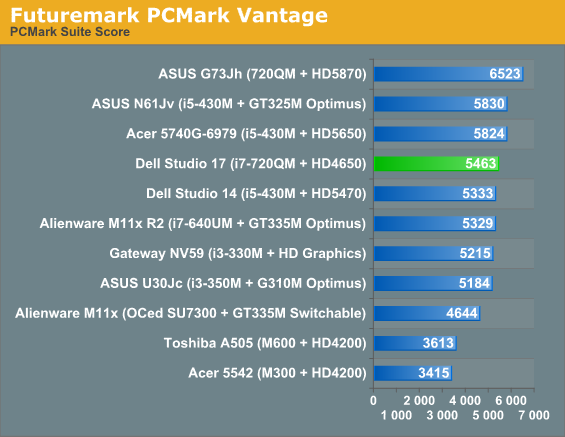
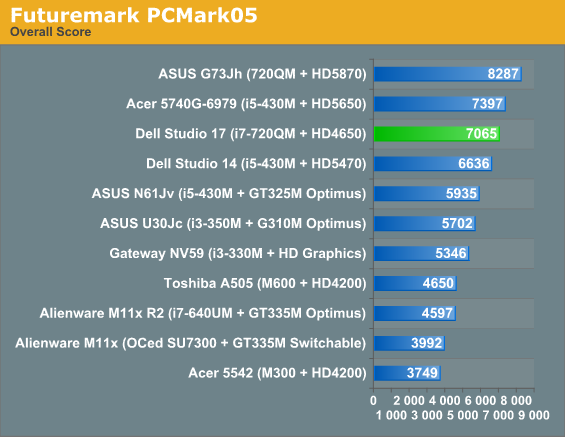
Our PCMark Vantage and PCMark05 scores are a bit lower than we'd like to see them, but this can be attributed to the ATI Mobility Radeon HD 4650 not pulling as much weight compared to some of the other graphics solutions available. Still, the Studio 17 consistently ranks near the top of the heap.


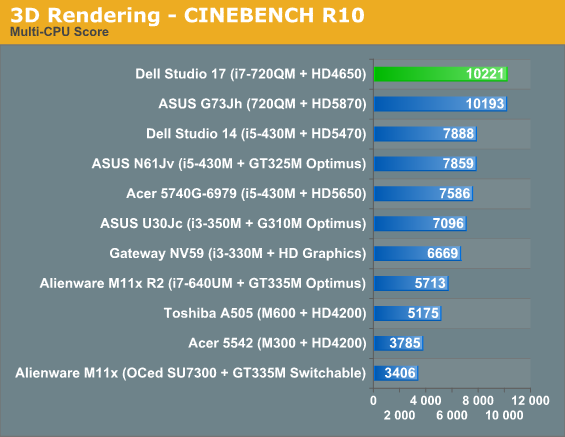
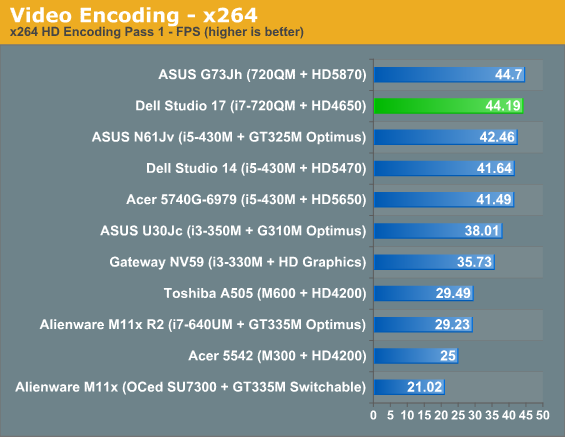
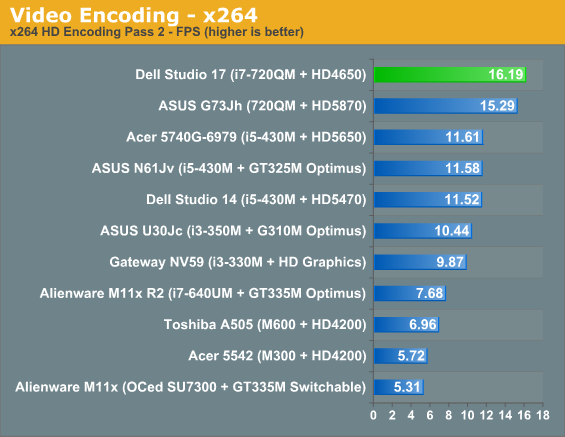
Again, Peacekeeper produces solid results but still on the low end of where we'd expect the Studio 17 to end up. That said, getting into Cinebench and the x264 encoding tests show the i7-720QM rocketing to the top of the heap where it should be. It's tough to say exactly why the Studio 17 stumbles in the Futuremark-based tests—maybe it's the Radeon HD 4650?—but either way, it performs beautifully when we leave that suite.










41 Comments
View All Comments
SteelCity1981 - Thursday, August 26, 2010 - link
Intel Core i7-720QM(4x1.6GHz, 45nm, 8MB L3, Turbo to 2.8GHz, 45W)
It should be....
Intel Core i7-720QM
(4x1.6GHz, 45nm, 6MB L3, Turbo to 2.8GHz, 45W)
The Intel Core i7-72xQM series use only 6MB of L3 cache.
JarredWalton - Thursday, August 26, 2010 - link
Fixed.InternetGeek - Thursday, August 26, 2010 - link
Hi Guys,I noticed the benchmarks do not include the HP Pavillion 17". Is it because it was too slow or just not available for the benchmarks?
Still reading the review...
JarredWalton - Thursday, August 26, 2010 - link
It's a case of reviewing what we've received... or in this case, what Dustin bought for himself. The reason he didn't even consider the Pavilion 17 is because he's a multimedia (video) user. He wanted quad-core i7, but he also needs Firewire support and would really like ExpressCard/34 as well. The Pavilion 17 lacks both features.kmmatney - Thursday, August 26, 2010 - link
I would love to get a new laptop, but my current Dell, which is over 3 years old, has a 17" 1920 x 1200 screen. Giving up those 300 vertical pixels is going to suck. I really wish they would go back to 16:10 screens, at least for laptops.I have to say my Dell Inspiron 9400, with a merom T7200, has been very good. It has taken a tremendous amount of travel and abuse (a 6 foot drop onto a concrete floor once) and has held up well. My next machine will be another Dell laptop, if I can help it, but I really hate the vertial screen resolutions.
B3an - Thursday, August 26, 2010 - link
If you read the display page you would have seen that you can choose a 1080p res display. Still less pixels but not many.I agree about 16:10, it's much better.
Nfarce - Thursday, August 26, 2010 - link
That's exactly what he's referring too (as I did below): 1920x1080 vs. 1920x1200.Oh and one other thing I forgot to mention for comparison's sake to the older Dell Inspirons of 2006-2007 E-series: even a 15" E1505 could be optioned with a 1920x1200 high resolution display.
Nfarce - Thursday, August 26, 2010 - link
I agree w/kmmatney. I also have a 17" Inspiron (E1705 that's 4 1/2 years old now with ATi x1300 and T7200). It ran the older games like HL2 and Return To Castle Wolfenstein great at 1920x1200. I still use it as a gaming machine for older games when I get the nostalgic feeling. But the days of 1920x1200 are drawing to a close even for regular LCDs, of which I have a 26" Samsung. Everything nowadays is at 1920x1080. Can anyone offer a logical explanation for that? I'm really bothered by this because I use Microsoft FSX a lot and 16x9 aspect resolution pinches the cockpit gauges somewhat.JarredWalton - Thursday, August 26, 2010 - link
Logical? Well, it's simply a case of the LCD panel makers being able to get more displays out of a sheet of glass substrate with 16:9 than with 16:10. If you do the math, of course, a 17" 16:10 panel is around 130 in^2 and a 17.3" 1080p panel is 128 in^2, but the glass sheets they're made from (with all the LCD circuitry and such) may be better sized for the wider+narrower panels.The other side of the equation is that with movies going widescreen, and the push for PCs to become more multimedia capable, WS displays make sense. That doesn't mean 16:9 is better than 16:10, but in some marketing departments....
erple2 - Thursday, August 26, 2010 - link
<quote>The other side of the equation is that with movies going widescreen, and the push for PCs to become more multimedia capable, WS displays make sense.</quote>Normally, I'd agree, but movies are generally far more than 16:9 AR. They're generally in the anamorphic (2.33:1) or 1.87:1 (not the 1.78:1, aka 16:9).
I think that your second guess (that the glass made for LCD panels lends itself better to 16:9) is probably the right one. I also suspect that became a circular "problem" - Someone somewhere decided to try 16:9 instead of 16:10, marketed that as the AR used for HD (720p or 1080p), then found out it was cheaper to make (for the same "size"), then stuck with it.